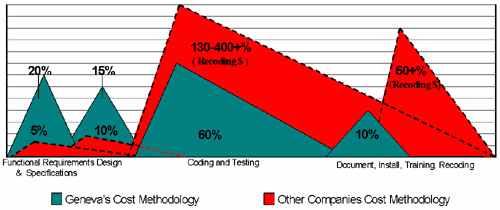How Geneva's Powerful, Four-Step Project Development Methodology Works for You

Geneva's project methodology is designed to guide for the planning, building/coding and deploying phases of the project life cycle. By using this models, concepts and practices organizations can:
- Create solutions that better match business and user requirements
- Speed up development and deployment cycles
- Lower the cost of owning technology
- Improve success on planned projects
1. Business Analysis and Functional Requirements
First, the Geneva Team analyzes your business, user, cost, system and performance requirements up front. Alignment of business and the implications thereof in information technology priorities in this phase is crucial. Early investment in analysis & design can really pay off by saving time in coding and redesign. It's much like a construction project. The better the design, specifications and blueprints - the better the quality and budget of the finished product. When an inadequate amount of time is spent on the front end of a project, numerous changes and additions occur during coding and testing. Cost increases can grow exponentially if this crucial step is skipped.
In this crucial step we endeavor to clearly understand and define your Business Purpose, Business Objectives, Key Features & Functional Requirements, Critical Success Factors, Constraints, Roles & Responsibilities, Actors and User Interfaces, and a Preliminary Design Architecture. These key Project Elements along with a Preliminary Estimate are developed for your review and approval. See the Example Application for a detailed look at how this can work for you.
2. Top Level Design and Specifications
After your business needs and functional requirements are defined, a Geneva Team creates a draft of the system and/or software architecture. Major project features, interfaces, functionality, and specifications are clearly defined and approved. This phase is essential to translate the above business analysis and user requirements into software project specifications so that the scope of work is clear prior to coding. A more complete project estimate and timeline is established after approval of this phase.
3. Detail Design, Coding and Testing
The Geneva Team creates a detailed design of the project - which may include project features, interfaces, functionality, look and feel, data sources and transactions, reports, and input screens. A project schedule and estimate are created and approved at this point. Changes in the current IT capabilities vs. new requirements and migration or integration plans are established. Coding and regular project update meetings are planned. Project milestones and key customer review dates are scheduled. As each major segment of the project is completed, usability testing is performed to check program quality, security and functionality.
4. Documentation, Installation and Training
Finally, the Geneva Team documents the design and coding details of the project internally. This is very important to more efficiently plan for changes and modifications in the future to accommodate new technology, customer or user requirements. The new software is then installed at the customer site and user training is conducted to improve understanding of usability and features. The Geneva Project Development Methodology has proven to save a significant amount of customer resources, time and investment.
Contact us for an initial no-obligation consulting session.


